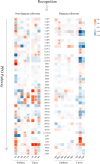Insights to micropsoridia Nosema bombycis congenital infection and host immune responses in the embryo and larva stages of silkworms
- PMID: 40596812
- PMCID: PMC12211725
- DOI: 10.1186/s12864-025-11762-z
Insights to micropsoridia Nosema bombycis congenital infection and host immune responses in the embryo and larva stages of silkworms
Abstract
Microsporidia are a group of intracellular and unicellular eukaryotic parasites, which can nearly infect all animals, including human beings. As the first identified microsporidia, Nosema bombycis is a world-wide threat for silkworm eggs production, it can cause the congenital infection via transovarial transmission. It is important for pathogenesis elucidation to unravel the molecular characteristics of N. bombycis proliferation and host immune responses to the congenital infection in embryo and larva stage. Here, we adopted dual RNA-seq approach to investigate and compare the dynamic molecular pattern of pathogen proliferation and host immune responses between diapause and non-diapause silkworm eggs. Our results showed the N. bombycis proliferation in non-diapause silkworm eggs is a continuous process, many parasites enter the sporogony stage at 2 days post-oviposition (dpo). For newly hatched larva (1 dph), the abundance of pathogen mRNA sequences is up to 2.32% in non-diapause strain, far higher than 0.34% of diapause strain, the main reason is the hot HCl bath treatment at 24 h post-oviposition for diapause silkworm eggs with the aim to free the egg diapause. As to immune responses, whatever for diapause strain or non-diapause strain, there is stronger immune responses to congenital infection in larva stage than that of embryo stage, however, the host immune responses to congenital infection are fairly different between non-diapause and diapause strains of silkworms, especially in embryo stage. We found the surprising “First day Chaos” that there are 6,071 differential expressed genes (DEGs) at 1 dpo for non-diapause strain between infection group and uninfected group, but decreases dramatically to 109 DEGs at 2 dpo. In non-diapause strain, the earliest DEGs of antimicrobial peptides were up-regulated at 1 dpo, then is 5 dpo with up-regulated lebocin, 7 dpo with morLP-B1, morLP-B4. For non-diapause strain, the well-established immune responses were observed in newly hatched larvae. On the contrast, for diapause strain, the earliest DEGs of AMPs appear at 5 dph, the mature immune responses are well established at 5 dph too. In non-diapause silkworms, we observed obvious pathogen’s regulation in the main immune pathways including Toll, IMD, JAK-STAT and melanization at the different steps such as immune recognition, signal modulation and transduction, effectors. Taken together, our results for the first time provide a global molecular view of microsporidia proliferation and innate immunity responses in a congenital infection system and provide some new insights into immune development and establishment in the embryo and early larva stage of Bombyx mori.
Supplementary Information: The online version contains supplementary material available at 10.1186/s12864-025-11762-z.
Keywords: Bombyx mori; Nosema bombycis; Congenital infection; Immune response; Microsporidia; Transcriptome.
Conflict of interest statement
Declarations. Ethics approval and consent to participate: Silkworms are not a protected species and can be used as experimental materials without ethical approval. Consent for publication: Not applicable. Competing interests: The authors declare no competing interests.
Figures











Similar articles
-
Transcriptome analysis reveals changes in silkworm energy metabolism during Nosema bombycis infection.Pestic Biochem Physiol. 2021 May;174:104809. doi: 10.1016/j.pestbp.2021.104809. Epub 2021 Feb 27. Pestic Biochem Physiol. 2021. PMID: 33838710
-
Molecular and biochemical responses in the midgut of the silkworm, Bombyx mori, infected with Nosema bombycis.Parasit Vectors. 2018 Mar 6;11(1):147. doi: 10.1186/s13071-018-2755-2. Parasit Vectors. 2018. PMID: 29510742 Free PMC article.
-
Comparative proteomic analysis of differentially expressed proteins in the Bombyx mori fat body during the microsporidia Nosema bombycis infection.J Invertebr Pathol. 2017 Oct;149:36-43. doi: 10.1016/j.jip.2017.06.009. Epub 2017 Jun 28. J Invertebr Pathol. 2017. PMID: 28668257
-
Nosema bombycis: A remarkable unicellular parasite infecting insects.J Eukaryot Microbiol. 2024 Sep-Oct;71(5):e13045. doi: 10.1111/jeu.13045. Epub 2024 Aug 2. J Eukaryot Microbiol. 2024. PMID: 39095558 Review.
-
Strategies for diagnosing Nosema bombycis (Microsporidia: Nosematidae); the agent of pebrine disease.Mol Biochem Parasitol. 2024 Dec;260:111645. doi: 10.1016/j.molbiopara.2024.111645. Epub 2024 Jun 20. Mol Biochem Parasitol. 2024. PMID: 38908801 Review.
References
Grants and funding
- SWU-XDJH202322/Fundamental Research Funds for the Central Universities
- cstc2021jcyj-msxmX1003/The Natural Science Foundation of Chongqing, China
- COMAITS202311/The Chongqing Modern Agricultural Industry Technology System
- COMAITS202311/The Chongqing Modern Agricultural Industry Technology System
- 32272942/National Natural Science Foundation of China
LinkOut - more resources
Full Text Sources
Research Materials

